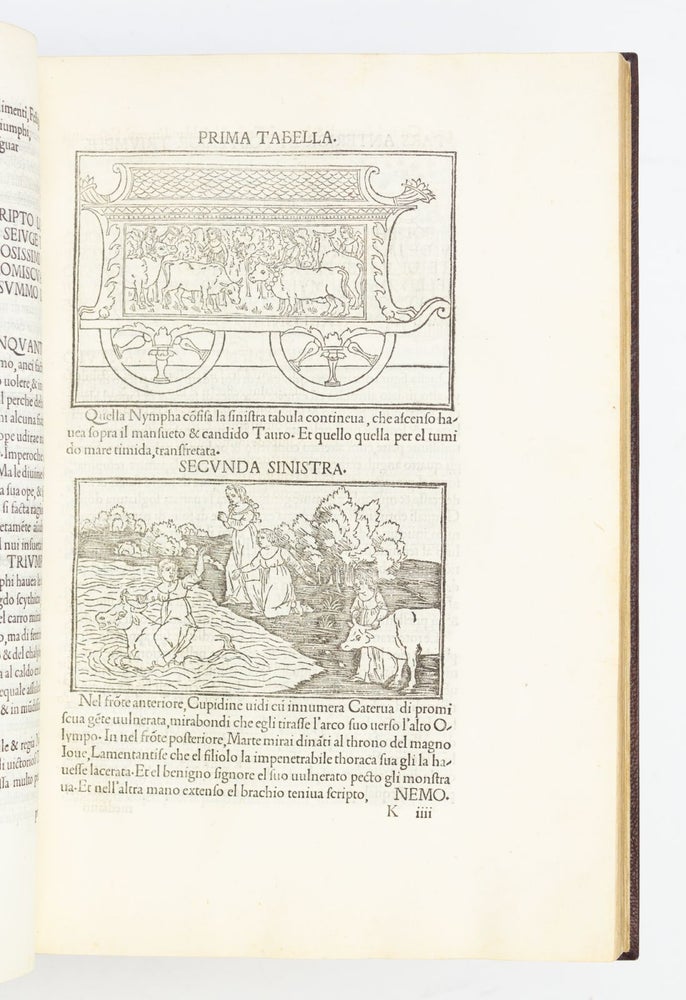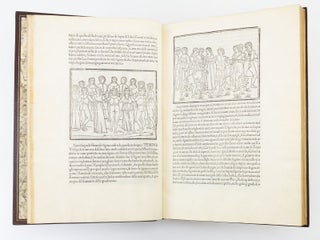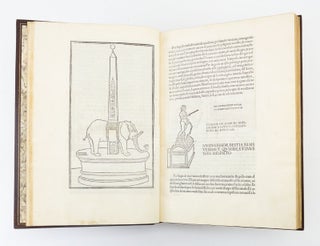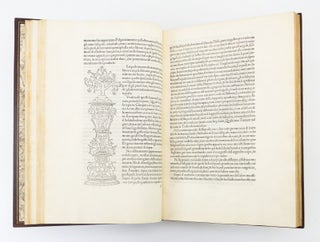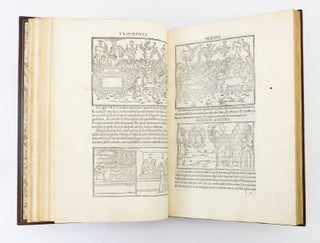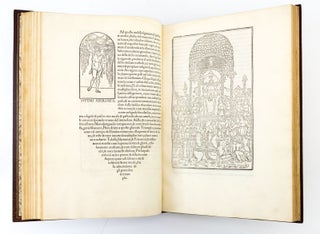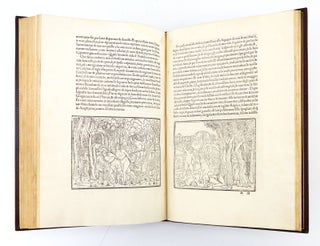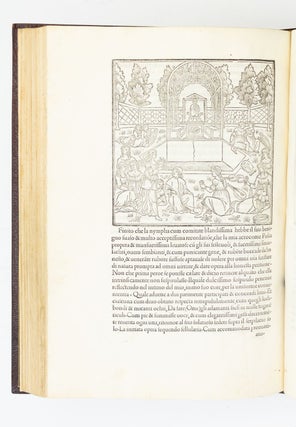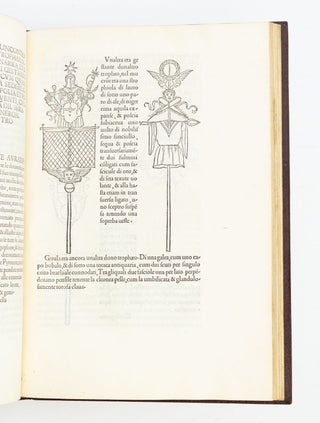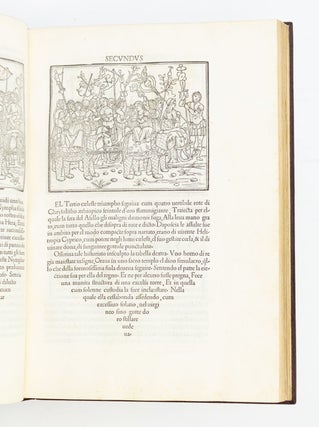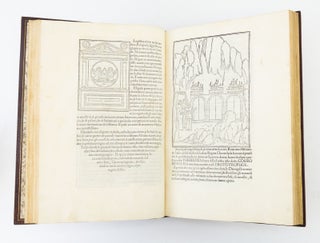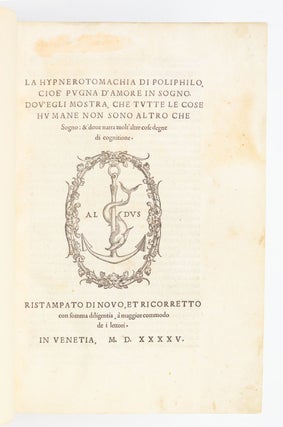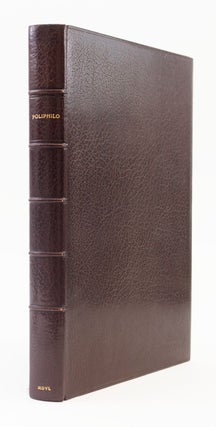LA HYPNEROTOMACHIA DI POLIPHILO, CIOÈ PUGNA D'AMORE IN SOGNO. DOU'EGLI MOSTRA, CHE TUTTE LE COSE HUMANE NON SONO ALTRO CHE SOGNO: ET DOVE NARRA MOLT'ALTRE COSE DEGNE DI COGNITIONE.
(Venetia [Venice]: in casa de' Figliuoli di Aldo, 1545). 310 x 212 mm. (12 1/4 x 8 3/8"). [234] leaves. Second Printing.
Modern dark brown crushed morocco, raised bands, gilt titling to spine, gilt-ruled turn-ins, leather hinges, marbled endpapers, top edge gilt. With Aldine device on title page and final page, and 170 WOODCUTS, nine of which are full-page (count includes tablets with typeset text within, as per Mortimer). Mortimer 131; Sander 2057; Essling 1199; Adams C-2414; Kallendorf 302; Renouard 133:14; EDIT16 CNCE 12823; USTC 823513. See also: John Harthan, "The History of the Illustrated Book" pp. 80-82; and Martin Lowry, "The World of Aldus Manutius," pp. 120-25. ◆Title page with faint discoloration in two small marginal spots (to remove indications of ownership?), one leaf in last gathering a little browned, final three leaves (including colophon) with repair to fill small worm trail, occasional quite trivial spots to margins; in all other ways, A VERY FINE COPY--the text remarkably clean, fresh, and bright, the margins especially generous, and the binding unworn.
A masterpiece of Renaissance book production, this is one of the most beautiful printed works ever created, being especially desirable for the refinement of its illustrations, extraordinary design, and thoughtful interaction of word and image. "Poliphilo's Strife of Love in a Dream," as it is often translated, is a complex allegorical romance that follows the love-sick Poliphilo as he pursues the object of his desire, Polia, through a dream world rich with architectural forms and antique splendors. Written in an unusual hybrid of Latin and Italian, the text is usually credited to the Dominican monk Francesco Colonna (1443/4-1527) due to the presence of an acrostic, formed by the first letter of each of the 38 chapters, spelling out "POLIAM FRATER FRANCISCVS COLVMNA PERAMAVIT" ["Brother Francisco Colonna desperately loved Polia"]. Though connected to the monastery of San Giovanni e Paolo, Colonna apparently lived outside the monastery walls and was something of a miscreant. Martin Lowry describes him as "a more than usually vicious character, who had twice been called before the highest authorities of his Order and once expelled from Venice on so many charges that the senior members of his community had also been held under threat. . . . [He] accused several of his superiors of sodomy, then retracted and was himself accused and convicted of seducing a young girl." Although scholars disagree about the literary merits of Colonna's erotic tale, its story and dream-world setting provided the perfect stimulus for the artistic imagination. Often arcane and mysterious, the images include ruins, obelisks, temples, and other architectural delights, strange artifacts and bits of masonry bearing inscriptions, much Christian and pagan symbolism, and various ceremonies, rituals, and processions. The artist/engraver of this work is anonymous, though the quality of the illustrations has led scholars to suggest major artists such as Andrea Mantegna, Gentile Bellini, and even Raphael as possible candidates. Recent scholarship now favors Venetian miniaturist Benedetto Bordon, based on the presence of a "b" on two of the illustrations. As Lowry notes, "the illustrator, whoever he was, produced a masterpiece which towers above any contemporary and carries the interdependence of word and picture into a new dimension. Arches, temples, vases, sculptures, inscriptions, [and] chariots were traced out as the writer had described them, not only with expertise but with a kind of zest which gave the completed whole both its brilliance and its danger." The 1499 original edition done by Aldus Manutius had been a financial disappointment (probably due to the expense of the book as well as the relatively small audience to whom it would have appealed), but the work enjoyed a renewed surge of popularity when the present 1545 reprint by Aldus' son Paulus appeared. The original wood blocks are reused in our second printing (with the exception of six that had to be recut due to damage, as per Mortimer). The earlier printing is now extravagantly expensive, and our second edition, while costly, provides a page-for-page reprint with a very much reduced price tag. (ST18158)
Price: $90,000.00

